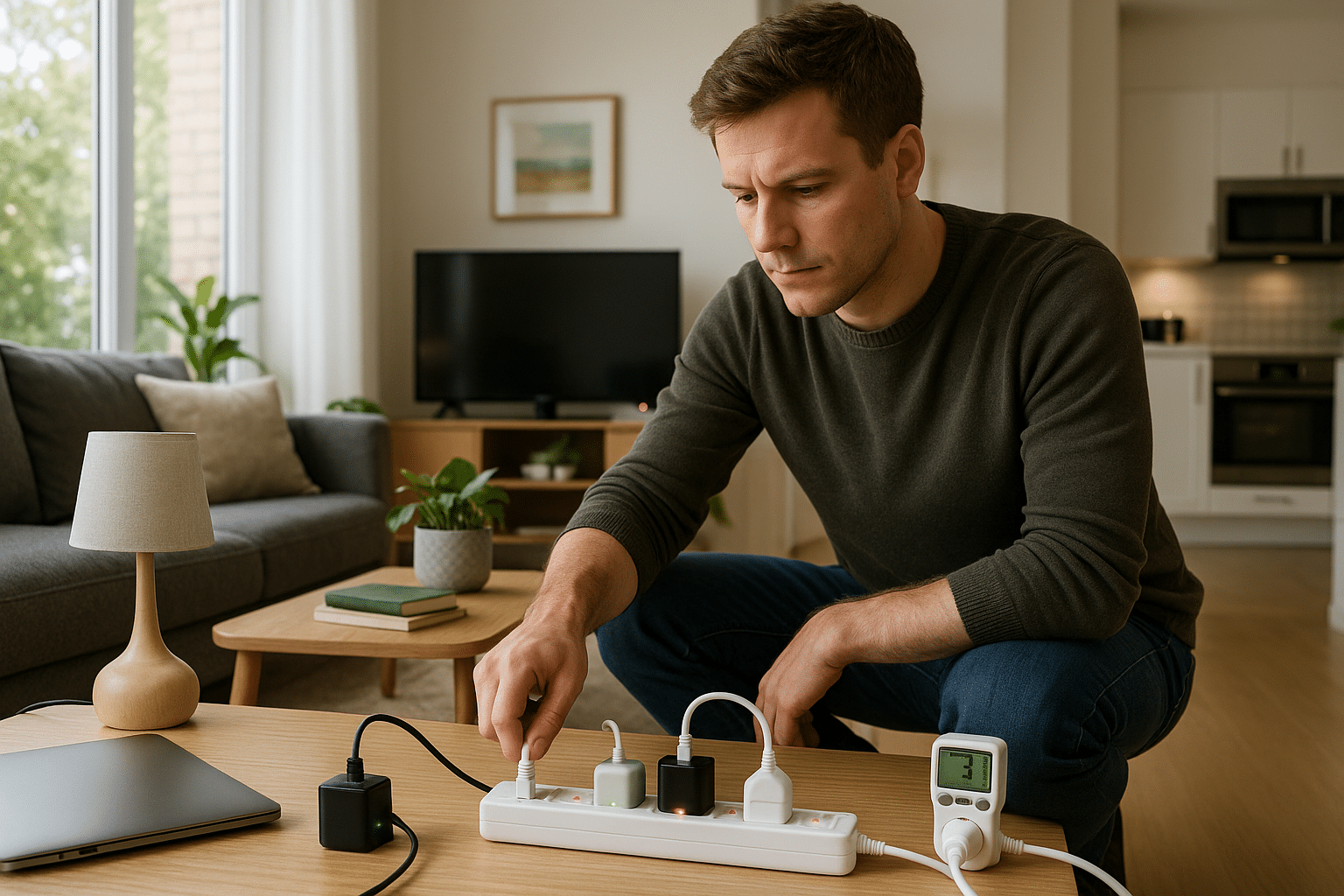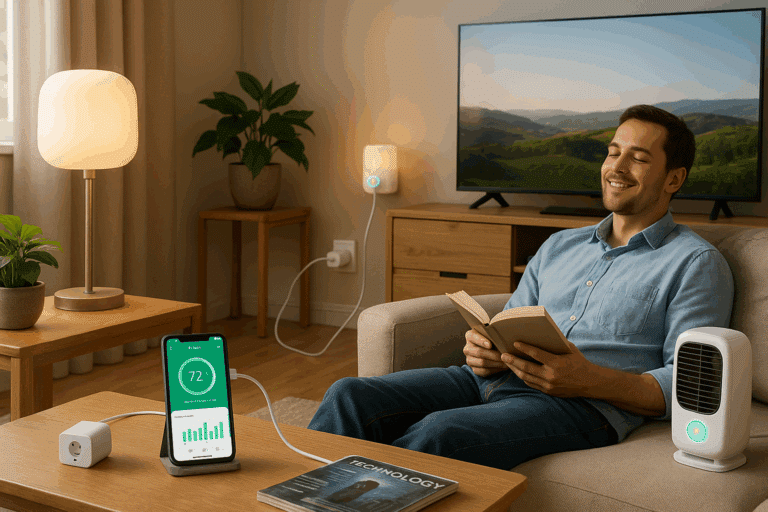But did you know that a significant portion of this energy is actually wasted? Let’s discuss a silent enemy to energy efficiency — phantom loads. Phantom loads refer to the electricity consumed by devices when they’re not actively in use, but still plugged in. Also known as standby power or vampire power, it’s a subtle energy drain that can inflate your energy bill and contribute to environmental degradation. 🌎
It’s shocking to think that our home could be riddled with such energy vampires, sucking up power in the background while our focus is directed elsewhere. But what if there was a way to tackle these invisible power drains, cutting unnecessary energy consumption, and ultimately, saving money? 💡💰
Well, there is. This in-depth article will explore the concept of phantom loads, their impact on our daily lives and the environment, and more importantly, the strategies to reduce these sneaky energy drainers.
Let’s start by understanding the phenomena of phantom loads. Despite the ominous term, the concept is rather straightforward. Any device that consumes power when not in active use, but still plugged in, is contributing to phantom loads. This includes your microwave clock, standby mode on your TV, and even your phone charger when it’s not charging anything. Surprising, isn’t it? 🔌
The Impact of Phantom Loads
The next part of our discussion will delve into the impact of these hidden energy guzzlers. Although the individual contribution of each device may seem negligible, when added up, the total power consumed by these ‘phantoms’ can account for up to 10% of a household’s energy usage. But it doesn’t stop there. Phantom loads are also a significant contributor to our carbon footprint. This wasted energy often comes from burning fossil fuels, contributing to greenhouse gases and climate change. 🏭🌪️
Strategies to Reduce Phantom Loads
The good news is, there are ways to slay these energy vampires. The final section of this article is going to detail practical steps you can implement today to start reducing phantom loads. Spoiler alert: It’s easier than you might think. From smart power strips to energy-efficient appliances, there are numerous ways to reduce these unnecessary energy drains.
So buckle up for an enlightening journey as we delve deep into the world of phantom loads. Whether you’re an energy-conscious homeowner, a technology enthusiast, or simply someone looking to cut back on unnecessary expenses, this article is for you. By the end, you will not only have a solid understanding of phantom loads and their impacts but also a toolkit of strategies to minimize their influence on your energy consumption and the environment. Let’s start our journey towards a more energy-efficient lifestyle. 🌱🔋
Shall we start the energy revolution right from our homes?
Understanding Phantom Loads: The Hidden Energy Wasters
The term “phantom load” might sound like something out of a ghost story, but it’s a real-world issue with significant impact on both our wallets and the environment. Also known as “vampire power”, a phantom load is the energy consumed by an electronic device when it’s switched off but still plugged into a power outlet. This can include anything from your television and computer to your coffee maker and microwave. As harmless as it may seem, phantom load contributes to unnecessary energy use, leading to higher electricity bills and increased carbon footprint.
It’s surprising to know that according to the U.S. Department of Energy, about 25% of the power used by home electronics is consumed while they’re turned off. That’s an astounding amount of wasted energy. But, there are effective ways to combat this issue and save both energy and money.
The first step towards curbing phantom loads is understanding which devices in your home are the biggest culprits. Generally, any device with a standby mode, a remote control, or a digital clock, tend to use power even when they’re off. This includes televisions, gaming consoles, microwaves, printers, and computers, among others.
Ways to Identify and Measure Phantom Loads
There are specific tools designed to measure the power usage of your home appliances. Devices like Kill A Watt or Belkin Conserve Insight Energy Use Monitor can help you identify which devices in your home are draining power even when not in use. These tools are relatively straightforward to use; just plug the device into the energy monitor, and it will display the amount of energy being consumed.
Another way to identify phantom loads is by looking out for any device that stays warm even when it’s switched off. Any warmth indicates that electricity is being consumed. Moreover, devices with a standby light or a digital display are also likely to draw power continuously.
As a tech enthusiast, I strongly recommend watching the following video: ‘Phantom Loads’ by Veritasium on YouTube. It provides an in-depth understanding of phantom loads and offers practical tips on how to reduce them.
Effective Strategies to Reduce Phantom Loads
Once you’ve identified the phantom loads in your home, it’s time to take action. One of the simplest methods is to unplug your devices when they’re not in use. While this may seem inconvenient, it can save a significant amount of energy and reduce your electricity bills.
Power strips are another useful tool to combat phantom loads. By plugging multiple devices into a power strip with a switch, you can turn off all the devices at once when they’re not in use. This eliminates the need to unplug each device individually, saving time and effort.
Advanced power strips (APS) take this a step further. These power strips can detect when a device is in standby mode and automatically cut off power to it. Some models even allow you to set a timer to turn off power to the devices plugged into it.
Comparing Traditional Power Strips and Advanced Power Strips
It’s essential to understand the difference between traditional power strips and advanced power strips to make an informed decision. Here is a comparative table to help you distinguish between the two:
| Features | Traditional Power Strip | Advanced Power Strip |
| Power switch | Yes | Yes |
| Energy saving | No | Yes |
| Standby power cut-off | No | Yes |
| Timer feature | No | Yes |
In conclusion, it’s clear that APS offers more features and advantages compared to traditional power strips. While they may be more expensive, they can save you more money in the long run by significantly reducing your energy consumption.
Conclusion
Phantom loads might seem insignificant, but they can add up to a considerable amount of wasted energy and money. By identifying and eliminating these energy vampires, you can reduce your carbon footprint and save on your electricity bills. So, let’s start unplugging those devices and stop the phantom loads now!

Conclusion
In conclusion, after delving into the vast world of Information Technology and Software Engineering, it’s clear that these fields are vital to our current digital age. They are the backbone of most systems that power our daily lives, from mobile apps to complex databases.
The importance of these disciplines cannot be overstated. It’s not just about writing code, but also about understanding how to design and implement a system that meets the user’s needs and expectations. In this article, we’ve covered several fundamental concepts, such as the software development life cycle, various software engineering models, programming languages, and more. Each of these elements plays a crucial role in creating software that is reliable, efficient, and user-friendly. 🖥️💻🚀
Moreover, we’ve delved into some of the challenges faced in software engineering, such as maintaining code quality, managing complex projects, and ensuring security. By understanding these issues, you can better appreciate the complexity and nuances of this field. However, with the right strategies and tools, these challenges can be effectively managed, leading to successful projects and products. 🔐🔧
Lastly, the article highlighted the importance of continuous learning in IT and Software Engineering. The tech industry is constantly evolving, and professionals need to keep up with the latest trends, technologies, and methodologies to stay competitive. Fortunately, there are numerous resources available online for continuous learning, such as online courses, webinars, podcasts, and more. So don’t hesitate to explore these resources and broaden your knowledge. 📚💡
This article was just a brief overview of the vast field of IT and Software Engineering. There’s so much more to explore and learn, so don’t stop here. Keep digging, keep learning, and keep innovating. After all, it’s through innovation that we can create solutions that improve our lives and shape the future.
Feel free to share this article with others who might find it helpful or interesting. And if you have any thoughts, questions, or experiences to share, please leave a comment below. We’d love to hear from you! 😊👍
You may refer to some online resources for further reading:
– [Computer Science Unplugged](https://csunplugged.org/en/) – An amazing resource to understand basic computer science concepts.
– [MIT OpenCourseWare](https://ocw.mit.edu/index.htm) – Free online courses from MIT.
– [Codecademy](https://www.codecademy.com/) – A platform to learn coding interactively.
– [W3Schools](https://www.w3schools.com/) – A comprehensive web development tutorial site.
This is a field where your journey of learning never ends. So, let’s keep the conversation going, share the knowledge, and continue to learn and grow together. As a famous saying goes, “Knowledge shared is knowledge doubled.” Let’s double up! 🚀
Article references:
1. [IEEE Computer Society](https://www.computer.org/)
2. [Association for Computing Machinery](https://www.acm.org/)
3. [Stack Overflow Developer Survey 2021](https://insights.stackoverflow.com/survey/2021)
Remember, the future is created by what you do today, not tomorrow. So let’s shape the future of technology together! 👨💻🌐👩💻



